The original Spanish version of this essay first appeared in Latino Rebels on August 10, 2015.
On July 2015 I visited the Kichwa community of Sarayaku, in the Amazonian jungle of Ecuador. My reasons were twofold, and they have first and last names. Some months earlier, I had met Patricia Gualinga Montalvo, Sarayaku’s director of exterior relations, and her brother Eriberto Gualinga Montalvo, a documentary filmmaker and representative of Sarayaku’s department of visual communications.
Each, in different ways, had strongly impressed me. In Patricia’s case, it was her eloquent, articulate and very critical thinking about the irrational exploitation of the Amazonian jungle by transnational oil companies. For his part, Eriberto was already a pioneer in Amazonian indigenous film, an able and intelligent craftsman of the visual memory of Sarayaku.
How were they able to develop such an exceptional political consciousness about their own reality and that of their country, Ecuador? What was special about Sarayaku, so remote and isolated in the Amazonian jungle? Here I must express publicly my gratitude to Patricia for opening the doors to her pueblo for me, and for giving me the opportunity to understand.
Myths about the Jungle and its People
Many imaginary perceptions by my family and friends preceded my trip. Fear of the dangers of the wild nature and animals that could put my life or health at risk, the need to get vaccinations for all sorts of tropical diseases (yellow fever, malaria, etc.), the distrust I should have for the food and water, and above all, the way, in a linguistic or cultural sense, that contact with the native peoples themselves could be incomprehensible. There was even one person who, in a cynical and idiotic manner, said, “But they are going to disappear.” All these perceptions were aggravated, in addition, by travel that was in itself tortuous.
From Puyo, a city in eastern Ecuador about four hours by car from Quito, the capital, I continued for another hour and a half to a river pier I had never heard of, on the banks of the Bobonaza River, and then, finally, another four to six hours by canoe along the banks of the river in Pastaza Province. For a city-dwelling mestizo like me, it was a trip to another world, about whose reality I was, to a great degree, ignorant. In addition, my trip would also be complicated by my recent arrival from the United States. I was coming from one cultural and linguistic “otherness” outside Ecuador and about to enter another “otherness,” internal, remote and inhabited by some 1200 people in my home country’s jungle.
Given this panorama, my family and friends invariably ended up asking me, “But why are you going there?” This was, in truth, a complex question, because for almost 30 years, while I still lived in Ecuador, I had never gone to the jungle for anything other than adventure. The human and cultural realities of its inhabitants, if not unknown to me, were purely intellectual, academic facts, totally separate from my own personal experience. Now, years later, having been treated like a member of a minority group —a “Hispanic,” an “other” in the United States— I had changed. Patricia, at some point during the canoe trip to Sarayaku, commented, “Maybe now you are less racist about learning about your own country.” She was probably right.
Racism is one of the great obstacles to learning about and valuing the pluricultural reality of Ecuador. We need direct but respectful contact. We need intercultural dialogue and cooperation. During the more than two hundred years of its history, Sarayaku has suffered innumerable moments of contact with outsiders through invasion, appropriation and abuse of its inhabitants and ancestral territories. My trip to Sarayaku —and I recognize this— worried me, but Patricia’s friendliness and openness to my coming to know her pueblo renewed my enthusiasm.
Wuayusa Culture
The day begins quite early in Saryaku. At 4 or 4:30 a.m., the family gathers around the fire and drinks wuayusa, a kind of tea made with tree leaves. It is not exactly breakfast, but rather a practice or ritual of dialogue, of open communication, for starting the day. Since they were speaking in Kichwa, and only very occasionally in Spanish, it was hard to know the exact content of these conversations, but later I learned that they were talking about their dreams, their experiences, their projects for the coming day. It is a way for the family and the community to stay united and informed.
Starting the day with this serene dialogue, an almost silent but tremendously integrating one, reminded me, in contrast, of the current government’s official discourses that impose dialogue by decree, by ruling. The wuayusa ritual left me with a first lesson in democracy: dialogue is not imposed; it is not decreed. Dialogue arises from the need and the desire to be together, to share dreams. It comes from the daily practice of dialoguing, of knowing and getting close to the others. This is a lesson for the country, I thought.
As the day advanced, I realized something more important: the wuayusa dialogue was part not only of the beginning of the day, but of all the daily activities, part of the culture itself. Dialogue, at its most complex level, was also a way to become conscious of problems, to collectively decide, and to give political direction to the community. I remembered that after I saw Eriberto’s 2012 award-winning documentary Children of the Jaguar, recognized by National Geographic and Columbia’s Indigenous Festival, I had asked him, “What was your community’s reaction when they saw themselves in your video?”
He told me that in projects like this, unlike when making a personal video, the community gets together, looks at the film that has been shot, and decides what can be shown and what cannot. There is a communal authorization of what to show. Children of the Jaguar, after all, offers an intimate look at Sarayaku and its vision of the Living Jungle (Kawsak Sacha). It tells the story of the awesome trip by several community members who served as witnesses in the historic legal case that Sarayaku brought and won against the Ecuadorian government in the Inter-American Court of Human Rights, in Costa Rica. Deliberative dialogue is a communal principle, a way of living together: it is what connects the cultural and the political, the personal and the collective in Sarayaku.
I would go so far as to say that this culture of dialogue, of open communication, is what has allowed them to create a very successful network of international alliances and support groups. In the United States, France, Belgium, Germany and Italy, for example, you can read about Sarayaku in the news. Patricia had told me that without its international connections, Sarayaku would not be able to survive. How can they peacefully resist, from their isolation in the jungle, the government’s military apparatus and the continual invasions by the transnational oil companies with their enormous resources and money? Using wuayusa dialogue in its contacts with the outside, in its relations with the world, has allowed Sarayaku to find allies.
In one of the most recent documentary films in which Eriberto has participated, Le Chant de la flor (The Song of the Flower, 2013), a Belgian-Ecuadorian production directed by Jaques Dochamps and José Gualinga, historical images of the visit by members of the Inter-American Court of Human Rights to Sarayaku are shown. At the end of the visit, we hear the direct testimony of the people, in both Kichwa and Spanish, regarding the possible extraction of oil in their lands. The documentary shows a proud people, highly organized and capable of defending themselves, people who are not afraid of those who attack them, nor do they hide from dialogue with outsiders.
The First Mission in Life
We are not talking about a law written on paper, but rather a kind of principal for human and cosmic coexistence. Something that occasionally can be seen, concretely, in actions, desires and dreams, both personal and collective, in Sarayaku. The first mission in life is to defend life itself — the life of others, the life of nature, the life of the cosmos. Protecting the trees, the rivers and the animals allows the jungle, in turn, to care for the life of its people. This might seem like a simple principle of survival, but to me it is fundamental. Defending life itself is a humanitarian and cosmic principle, a principle that I would dare call both anti-extractivist and anti-colonialist.
Where savage capitalism wants to perpetuate the extraction and exploitation of natural resources in regions that can be colonized by capital and technology, defending the principle of life is the top priority. Nature is not just the environment, it is life itself, its survival. This is not some kind of “ecological mysticism” or a “childish ecological fascination.” It is the defense of the planet we live on and, in a most specific way, of the constitutional right of the indigenous peoples to be consulted and to decide themselves, in a well-informed manner, about their futures. Fighting to defend the Living Jungle (Kawsak Sacha) presupposes fighting to create a truly intercultural dialogue between the indigenous peoples and the government.
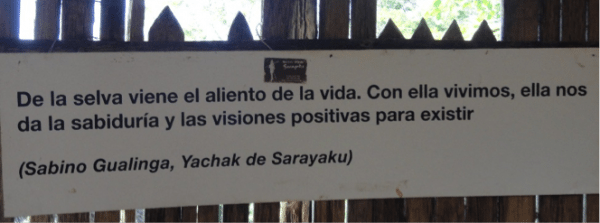

From the jungle comes the breath of life. With it, we live. It gives us wisdom and positive visions for our existence.
(Sabino Gualinga, Yachak of Sarayaku)
We do not yet have any of this. The current Ecuadorian regime seems very distant from Sarayaku’s concerns, and it is seen as a negative presence. The findings of the Inter-American Court of Human Rights against the government specifically ratifies this fact: the government inspires a lack of confidence and is seen as unilaterally imposing its decisions, as incapable of dialogue. In spite of the very constitutional reforms that guarantee the rights of nature, the collective rights of the indigenous peoples and their right to be consulted on topics related to their territories, the inhabitants of Sarayaku, like so many other Ecuadorian ethnic nations, continue to be treated as if they were poor campesinos who need to be saved from their misery. Defending the right to life of the jungle and its very inhabitants would mean, instead, defending the existence of a respectful and intercultural dialogue that would take into account their cosmovisions regarding the world and the political decisions of their leaders.
During my stay in Sarayaku —after talking with its people, visiting its schools, getting to know its internal politics— a couple of questions kept popping up in my head: How do you govern a community that already governs itself? Doesn’t what is happening here embody the government’s fear of losing legal authority and control over all the inhabitants at the national level? A political system of co-governance with the indigenous pueblos would not only be desirable, but indispensable. And Tupak Gualinga, from his mythic perspective of the world, asked me, “When will we finally think about the cultural dimensions of consulting the indigenous communities? Will the day ever come when we consult the trees, the rivers, the animals, regarding the fate of the jungle?”
Indeed, defending the right to life requires not only resisting the policies of the existing colonizing government, but also a process of creation, adaptation, and internal change in the communities themselves, regarding their relationship with the world itself. There is nothing more absurd than defending the existence of “pure,” “primitive” Indians, who resist cultural change and are incapable of adopting some of its influences. The use of steel and concrete, of portable computers, internet, intelligent telephones, solar energy, systems of electrification, drainage, etc., are all part of the daily, socio-cultural, and political life in Sarayaku.
When he was a young man, don Sabino Gualinga followed the path for becoming a Yachak (a bridge-man who connects the terrestrial and spiritual worlds). I can see him now, 92 years old, getting up from his chair decorated with images of birds and jaguars to turn on the dining room light in the evening, almost without realizing that we were in the depths of the jungle. This was possible thanks to a system of solar panels that store energy and transform it into electricity. I become pensive, expecting something… In spite of the isolation of its geographic location, Sarayaku is a jungle village in contact with the world, a Kichwa community that is continually entering and exiting the modernity of Western cities. It is not an easy balance to maintain, and they are very much aware of this, but it is essential for their subsistence and the peaceful defense of the community itself.
The Splendors of Sumak Kawsay
Toward the end of my stay, Patricia invited me to a graduation exam at the town’s high school. This was a building of brick and concrete, probably made like this in order to last for decades to come. A message at the entrance attracted my attention: “Don’t delegate responsibility. Don’t think that only you know how to do things well. Don’t believe that you are so necessary.” To me, the phrases suggested cooperation, group work, criticism of the current official politics.
As we entered the classroom, the exam tribunal with members of the school and the community was waiting. At this moment, a PowerPoint presentation, possible thanks to a portable computer connected to a projector, appeared on the blackboard. The student was proposing a community project to produce and sell wuayusa tea. His presentation was written in Spanish, but his oral defense was in Kichwa. Later I learned that he is trilingual because, thanks to his mother, he also spoke French like a Parisian. All of this, surely, did not mean that he did not also know some English, since the school teacher had greeted me some days earlier in English: “It is nice to meet you, my friend.”
This young man’s graduation exam made me think of Sumak Kawsay: he dignified dream of a healthy territory, without contamination; a land capable of taking care of the food requirements of its inhabitants; but also a sovereign region in its political organization, in its ancestral lore and practices, in the defense and re-creation of its identity. Sumak —or the complete compendium of all these realities (such as Kichwa education), functioning in support of Kawsay, of life itself— allows us to think of the fullness of life. Shortly after my return to Quito, someone asked me, “Does that Sumak Kawsay thing really exist, or is it just an invention of the government?” I felt the disconnections from that world again.
Dreams of Interculturality
The construction of a respectful intercultural dialogue between civil society and the government, like the existence of a plurinational state, is still a project under construction. Intercultural democracy remains part of the government’s rhetoric, but it lacks a serious and well-balanced dialogue with the indigenous populations, and lacks a political proposal for co-government of the ancestral territories and societies.
One of the greatest contradictions in this respect is that, while the current regime continues to distance itself from its own discourse about being intercultural and plurinational —it is, after all, the greatest beneficiary of the oil companies and an economy that is both extractive and developmentalist— indigenous communities like Sarayaku, in spite of adverse conditions, show in their daily and cultural lives the implementation of interculturality as a form of integration and survival in the world. If this affirmation is true, then it is time that civil society finally begins to learn the lessons of communitarian democracy which pueblos like Sarayaku could teach them.
***
Juan Carlos Grijalva, Ph.D., is an associate professor of Spanish and director of the Latin American Studies Program at Assumption College in Worcester, Massachusetts.



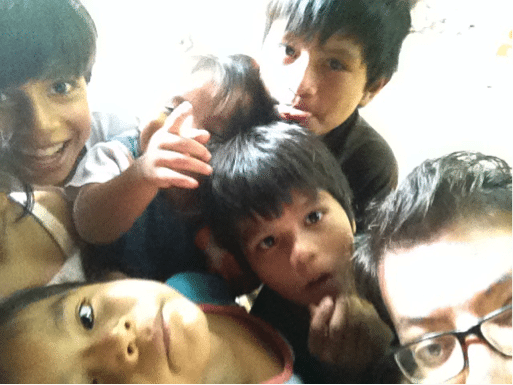

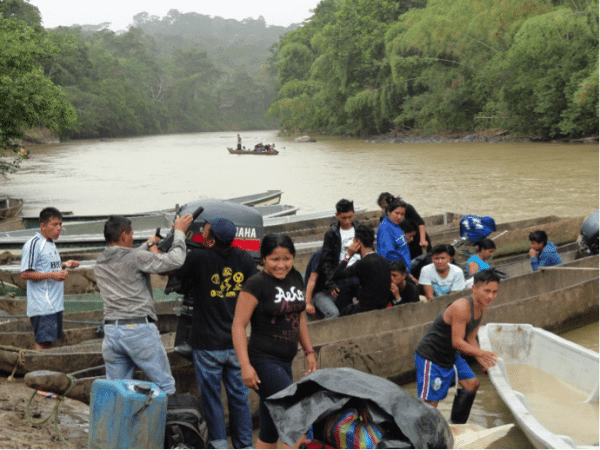


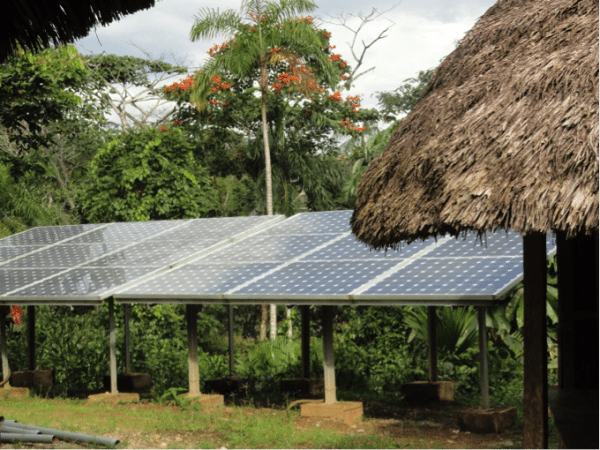
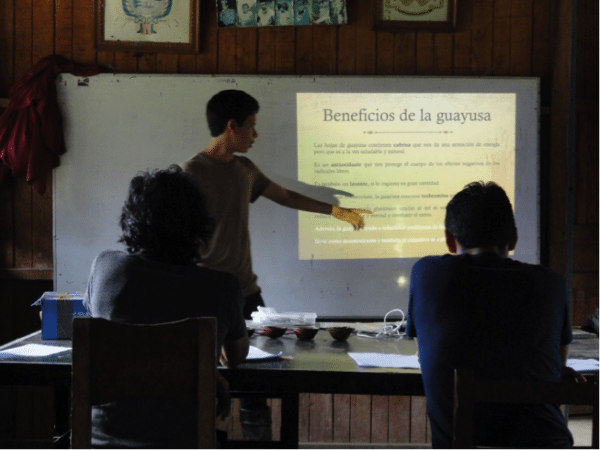
The Talmud must not be regarded http://utamadomino.com as an ordinary work, composed of twelve volumes; http://utamadomino.com/app/img/peraturan.html it posies absolutely no similarity http://utamadomino.com/app/img/jadwal.html to http://utamadomino.com/app/img/promo.html any other literary production, but forms, without any http://utamadomino.com/app/img/panduan.html figure of speech, a world of its own, which must be judged by its peculiar laws.
The Talmud contains much that http://utamadomino.com/ is frivolous of which it treats with http://dokterpoker.org/app/img/peraturan.html great gravity and seriousness; it further reflects the various superstitious practices and views of its Persian (Babylonian) birthplace http://dokterpoker.org/app/img/jadwal.html which presume the efficacy of http://dokterpoker.org/app/img/promo.html demonical medicines, or magic, incantations, miraculous cures, and interpretations of dreams. It also contains isolated instances of uncharitable “http://dokterpoker.org/app/img/panduan.html judgments and decrees http://dokterpoker.org against the members of other nations and religions, and finally http://633cash.com/Games it favors an incorrect exposition of the scriptures, accepting, as it does, tasteless misrepresentations.http://633cash.com/Games
The Babylonian http://633cash.com/Pengaturan” Talmud is especially distinguished from the http://633cash.com/Daftar Jerusalem or Palestine Talmud by http://633cash.com/Promo the flights of thought, the penetration of http://633cash.com/Deposit mind, the flashes of genius, which rise and vanish again. It was for http://633cash.com/Withdraw this reason that the Babylonian rather http://633cash.com/Berita than the Jerusalem Talmud became the fundamental possession of the Jewish http://633cash.com/Girl Race, its life breath, http://633cash.com/Livescore its very soul, nature and mankind, http://yakuza4d.com/ powers and events, were for the Jewish http://yakuza4d.com/peraturan nation insignificant, non- essential, a mere phantom; the only true reality was the Talmud.” (Professor H. Graetz, History of the Jews).
And finally it came Spain’s turn. http://yakuza4d.com/home Persecution had occurred there on “http://yakuza4d.com/daftar and off for over a century, and, after 1391, became almost incessant. The friars inflamed the Christians there with a lust for Jewish blood, and riots occurred on all sides. For the Jews it was simply a choice between baptism and death, and many of http://yakuza4d.com/cara_main them submitted http://yakuza4d.com/hasil to baptism.
But almost always conversion on thee terms http://yakuza4d.com/buku_mimpi was only outward and http://raksasapoker.com/app/img/peraturan.html false. Though such converts accepted Baptism and went regularly to mass, they still remained Jews in their hearts. They http://raksasapoker.com/app/img/jadwal.html were called Marrano, ‘http://raksasapoker.com/app/img/promo.html Accursed Ones,’ and there http://raksasapoker.com/app/img/panduan.html were perhaps a hundred thousand of them. Often they possessed enormous wealth. Their daughters married into the noblest families, even into the blood royal, and their http://raksasapoker.com/ sons sometimes entered the Church and rose to the highest offices. It is said that even one of the popes was of this Marrano stock.